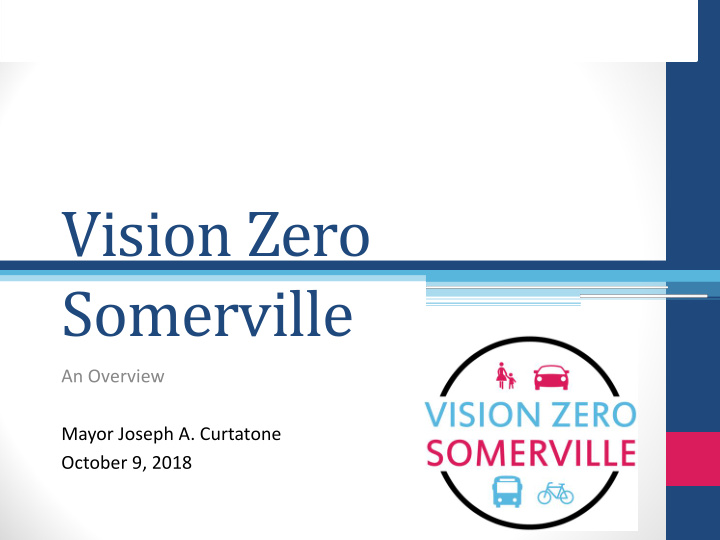



Vision Zero Somerville An Overview Mayor Joseph A. Curtatone October 9, 2018
About Somerville • ~80,000 population • Most densely populated city in New England • Walkable • Gold-level Walk Friendly Community • Overall Walk Score of 86/100 • Transit Accessible • Davis Square and Assembly Square MBTA stations • Six new Green Line stations by 2021 as part of Green Line Extension • 14 MBTA bus routes • 30% transit mode share (pre-GLX) • Bike Friendly • 5 th highest bicycle mode share in US in 2017 (9%) • Gold-level Bicycle Friendly Community • 12.5 miles of bicycle facilities
Vision Zero • Vision Zero is a worldwide movement to eliminate serious injuries and fatalities on our streets • Began in Sweden in 1997, spread throughout Europe in 2000s, and in US in 2010s • Action plans in NYC, San Francisco, Boston, Cambridge, and other US cities • Mayor Curtatone committed Somerville to Vision Zero in September 2017
Why Vision Zero? • Compels all City projects and programs to consider traffic safety and vulnerable road users • Reinforces the notion that even one traffic-related serious injury or fatality is too many • Treats our transportation network as a singular entity, rather than splitting into modes or focusing on individual corridors or intersections • Formalizes values and philosophies we already hold as a city
#CrashNotAccident • Most serious crashes are preventable, but common lexicon “car accident” assumes that they are unavoidable facts of life • “Accident” implies there’s nothing that could have been done to avoid a crash, considering both roadway/intersection design or the behavior of road users
Speeding vehicles kill
Why Vision Zero? • Vision Zero is a public health issue • Each year, more than 35,000 people are killed in traffic crashes in the United States, an epidemic that must be addressed with the same data-driven approach as any other public health crisis. • Safe streets encourage users to use cleaner, more sustainable transportation options. • Vision Zero is a public safety issue • Everyone who lives, works, and plays in Somerville interacts with our roadway network every day. • Vision Zero is a quality of life issue • Safe streets are more inviting to vulnerable road users to walk, bike, and take transit. Studies show that those who routinely walk or bike report a higher quality of life compared to those who primarily drive. • Vision Zero is an equity issue • Traffic violence disproportionately impacts disadvantaged and vulnerable populations.
US Cities Committing to VZ
Nine Components of a Strong Vision Zero Commitment Source: National Vision Zero Network Political Commitment P Multi-Disciplinary Leadership Ongoing Action Plan In Development Equity P Cooperation and Collaboration Ongoing Systems-based Approach P Data Driven P Community Engagement Upcoming Transparency P
Timeline • May 2014 Passed first Complete Streets ordinance in MA • November 2016 Reduced citywide speed limit to 25mph • September 2017 Mayor Curtatone commits to Vision Zero • June 2018 Vision Zero key initiative in City budget • October 2018 VZ Task Force formed • Oct – Nov 2018 Public Outreach • December 2018 Release draft Vision Zero Action Plan • Winter 2019 Gather public feedback • April 2019 Release final Vision Zero Action Plan
Speed Limits
Traffic Calming
Truck Sideguard Ordinance
Data Dashboard www.somervillema.gov/visionzero
Goals of this Task Force • Identify measurable short, mid, and long-term action items for inclusion in the Vision Zero Action Plan • Act as a liaison within your personal, professional, and advocacy network • Somerville Bicycle Advisory Committee • WalkBoston • Livable Streets Alliance • Pedestrian safety group • Somerville Cambridge Elder Services, etc. • After Action Plan is published, work with City officials implement action items and measure and report progress.
What is a Vision Zero action item? Vision Zero Action items are measurable goals toward achieving a more broad initiative that will help reduce the likelihood of serious crashes. • Evaluate and Expand Safety Zone Program • Expand one-street safety zones to neighborhood safety zones • Explore 20mph speed limit on larger scale (citywide, or all residential streets) • Improve public feedback mechanism for improving pedestrian and transit safety & access • Form a permanent Vision Zero Action Committee • Form a pedestrian and transit advisory committee (or committees)
What is a Vision Zero action item? Action items should focus on all the “E’s” – not every issue requires an engineering solution • Engineering • Enforcement • Emergency response • Education • (Policy) Enactment Action items should identify specific goals and milestones, so that items can simply be checked off as “Completed”, “In Progress”, or “Not Completed” without much explanation.
What is NOT a Vision Zero action item? Vision Zero Action items should NOT be: • Hyper-local/specific • “Install a crosswalk across Highland Avenue at Putnam Street” • Exception: Major intersections in need of re-design (Powder House Circle) as individual action items under a larger umbrella • Overly vague or non-committal • Unrelated to safety • Aesthetics • Noise abatement • Pollution reduction • …while worthy considerations, all items should help reduce serious crashes
What needs more discussion? • Mobility improvements that may not be safety improvements • Idaho Stop for bikes • Switching from exclusive pedestrian phasing to concurrent • Parking (vehicle and bicycle) • Expansion of Bluebikes network • Bus priority • Mode shift • While mode shift away from driving is a goal of the city, this may be a positive side-effect of VZ, rather than something we can directly control
Upcoming Schedule • Thursday, October 25 – VZ Task Force • Tuesday, November 13 – VZ Task Force • November – Public meetings
Recommend
More recommend